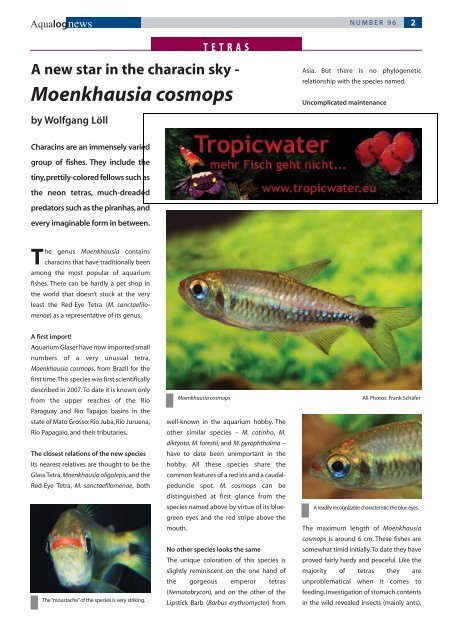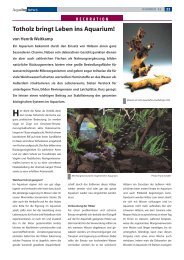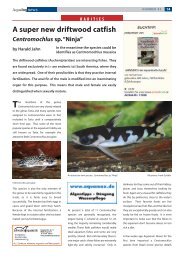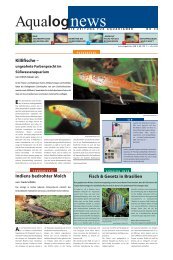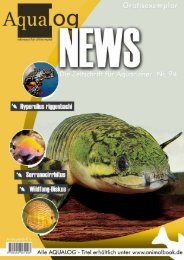Moenkhausia cosmops - Aqualog
Moenkhausia cosmops - Aqualog
Moenkhausia cosmops - Aqualog
Create successful ePaper yourself
Turn your PDF publications into a flip-book with our unique Google optimized e-Paper software.
<strong>Aqualog</strong>news NUMBER 96 2<br />
T<br />
he genus <strong>Moenkhausia</strong> contains<br />
characins that have traditionally been<br />
among the most popular of aquarium<br />
fishes. There can be hardly a pet shop in<br />
the world that doesn’t stock at the very<br />
least the Red-Eye Tetra (M. sanctaefilomenae)<br />
as a representative of its genus.<br />
A first import!<br />
Aquarium Glaser have now imported small<br />
numbers of a very unusual tetra,<br />
<strong>Moenkhausia</strong> <strong>cosmops</strong>, from Brazil for the<br />
first time.This species was first scientifically<br />
described in 2007. To date it is known only<br />
from the upper reaches of the Rio<br />
Paraguay and Rio Tapajos basins in the<br />
state of Mato Grosso: Rio Juba, Rio Juruena,<br />
Rio Papagaio,and their tributaries.<br />
The closest relations of the new species<br />
Its nearest relatives are thought to be the<br />
Glass Tetra, <strong>Moenkhausia</strong> oligolepis,and the<br />
Red-Eye Tetra, M. sanctaefilomenae, both<br />
TETRAS<br />
A new star in the characin sky -<br />
<strong>Moenkhausia</strong> <strong>cosmops</strong><br />
by Wolfgang Löll<br />
Characins are an immensely varied<br />
group of fishes. They include the<br />
tiny,prettily-colored fellows such as<br />
the neon tetras, much-dreaded<br />
predators such as the piranhas,and<br />
every imaginable form in between.<br />
The “moustache”of the species is very striking.<br />
<strong>Moenkhausia</strong> <strong>cosmops</strong> All Photos: Frank Schäfer<br />
well-known in the aquarium hobby. The<br />
other similar species - M. cotinho, M.<br />
diktyota, M. forestii,and M. pyrophthalma –<br />
have to date been unimportant in the<br />
hobby. All these species share the<br />
common features of a red iris and a caudalpeduncle<br />
spot. M. <strong>cosmops</strong> can be<br />
distinguished at first glance from the<br />
species named above by virtue of its bluegreen<br />
eyes and the red stripe above the<br />
mouth.<br />
No other species looks the same<br />
The unique coloration of this species is<br />
slightly reminiscent on the one hand of<br />
the gorgeous emperor tetras<br />
(Nematobrycon), and on the other of the<br />
Lipstick Barb (Barbus erythromycter) from<br />
Asia. But there is no phylogenetic<br />
relationship with the species named.<br />
Uncomplicated maintenance<br />
A readily recognizable characteristic:the blue eyes.<br />
The maximum length of <strong>Moenkhausia</strong><br />
<strong>cosmops</strong> is around 6 cm. These fishes are<br />
somewhat timid initially.To date they have<br />
proved fairly hardy and peaceful. Like the<br />
majority of tetras they are<br />
unproblematical when it comes to<br />
feeding. Investigation of stomach contents<br />
in the wild revealed insects (mainly ants),


